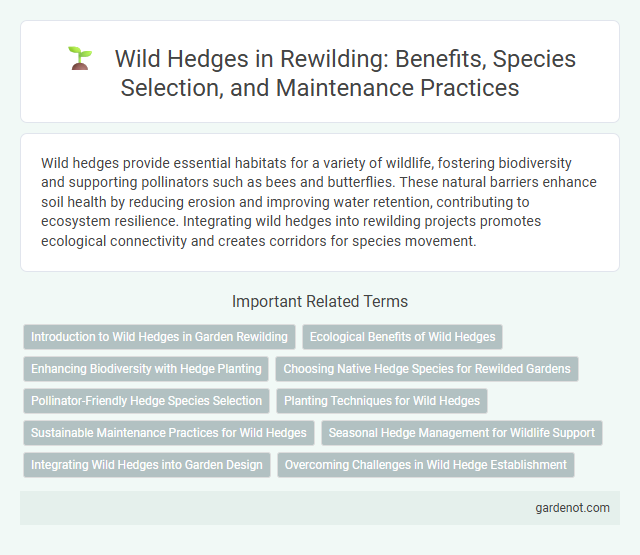Wild hedges provide essential habitats for a variety of wildlife, fostering biodiversity and supporting pollinators such as bees and butterflies. These natural barriers enhance soil health by reducing erosion and improving water retention, contributing to ecosystem resilience. Integrating wild hedges into rewilding projects promotes ecological connectivity and creates corridors for species movement.
Introduction to Wild Hedges in Garden Rewilding
Wild hedges in garden rewilding serve as essential habitats for native wildlife, promoting biodiversity by providing food, shelter, and corridors for species movement. These dense, mixed-species barriers support pollinators, birds, and small mammals while enhancing soil health through natural nutrient cycling. Integrating wild hedges into rewilded gardens contributes to ecosystem resilience and creates a dynamic, self-sustaining environment.
Ecological Benefits of Wild Hedges
Wild hedges act as vital ecological corridors, enhancing biodiversity by providing habitat and food sources for pollinators, birds, and small mammals. They contribute to soil stabilization and improve water retention, reducing erosion and supporting surrounding ecosystems. These living structures also sequester carbon, playing a significant role in climate regulation within rewilded landscapes.
Enhancing Biodiversity with Hedge Planting
Wild hedge planting enhances biodiversity by creating diverse habitats that support a wide range of wildlife, including pollinators, birds, and small mammals. Native species such as hawthorn, blackthorn, and hazel provide essential food sources and shelter, promoting ecosystem resilience and connectivity. Integrating wild hedges into landscapes supports ecological networks, improves soil health, and contributes to carbon sequestration.
Choosing Native Hedge Species for Rewilded Gardens
Selecting native hedge species such as hawthorn, blackthorn, and holly enhances biodiversity in rewilded gardens by providing essential habitats and food sources for local wildlife. These species support pollinators, birds, and small mammals while requiring minimal maintenance due to their adaptation to regional climate and soil conditions. Incorporating native hedges promotes ecological balance and strengthens the resilience of rewilded garden ecosystems.
Pollinator-Friendly Hedge Species Selection
Selecting pollinator-friendly species for wild hedges enhances biodiversity by providing essential nectar and pollen sources for bees, butterflies, and other pollinators. Native plants such as hawthorn (Crataegus monogyna), blackthorn (Prunus spinosa), and wild cherry (Prunus avium) support diverse insect populations while offering shelter and food for birds and mammals. Incorporating a mix of flowering shrubs and trees ensures a continuous bloom period, boosting pollinator activity and contributing to effective rewilding efforts.
Planting Techniques for Wild Hedges
Planting techniques for wild hedges emphasize native species selection, staggered spacing, and mixed-age planting to promote biodiversity and resilience. Root balls should be carefully handled to prevent damage, and trenches must be prepared with organic-rich soil to ensure healthy establishment. Incorporating layered planting, including grasses, shrubs, and trees, mimics natural succession and supports diverse wildlife habitats.
Sustainable Maintenance Practices for Wild Hedges
Sustainable maintenance practices for wild hedges involve minimal intervention to support biodiversity and ecological balance. Techniques such as selective pruning, seasonal trimming, and avoiding chemical pesticides encourage natural growth patterns and habitat preservation. Integrating native species and organic mulching further enhances soil health and resilience against pests and diseases.
Seasonal Hedge Management for Wildlife Support
Wild hedge management involves seasonal pruning strategies that enhance habitat quality for diverse wildlife species. Maintaining a balance between dense growth and open spaces during key breeding and feeding times supports birds, insects, and small mammals. Timely hedge trimming promotes flowering and berry production, crucial for pollinators and frugivores throughout the year.
Integrating Wild Hedges into Garden Design
Incorporating wild hedges into garden design enhances biodiversity by providing essential habitats for pollinators, birds, and small mammals. These natural barriers support native plant species, improve soil health, and create visually dynamic garden borders that blend seamlessly with the surrounding ecosystem. Strategic placement of wild hedges also aids in natural pest control and promotes ecological resilience within urban and suburban landscapes.
Overcoming Challenges in Wild Hedge Establishment
Establishing a wild hedge requires strategic planting of native species to enhance biodiversity and provide vital habitats for wildlife. Soil preparation and selecting drought-resistant plants are crucial to overcome issues of poor soil quality and water scarcity. Regular monitoring and adaptive management help address threats from invasive species and wildlife grazing, ensuring successful wild hedge growth.
Wild hedge Infographic

 gardenot.com
gardenot.com